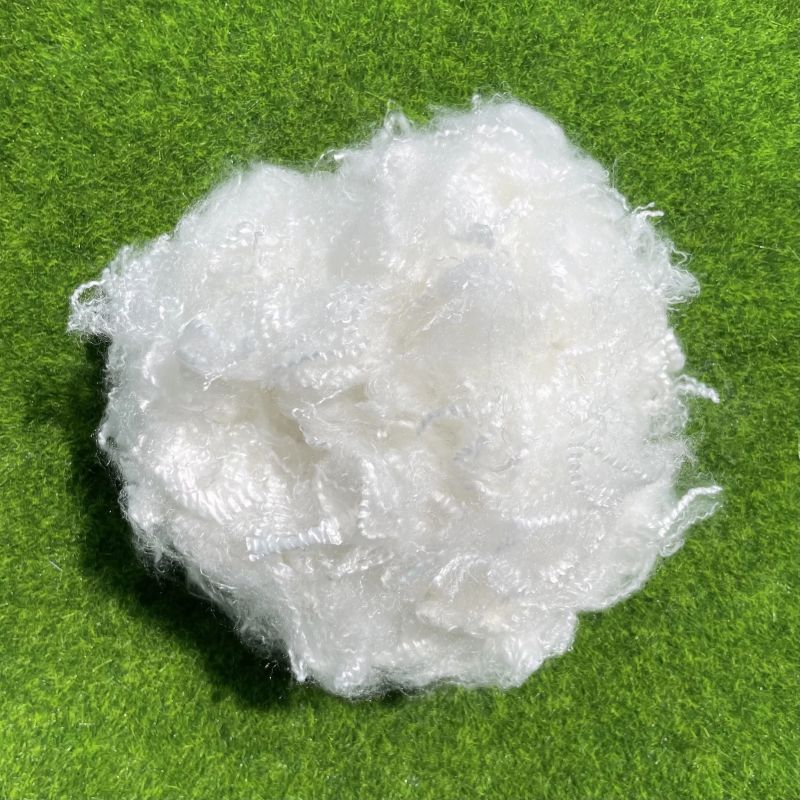Sustainability has gained importance across industries, with recycled materials, especially recycled polyester staple fiber (rPSF), gaining popularity in textiles. rPSF is now widely used in nonwoven fabrics for products like medical textiles, wipes, insulation, and hygiene products, offering both environmental and performance benefits.

What is Recycled Polyester Staple Fiber?
Post-consumer or post-industrial plastic waste, mainly PET (polyethylene terephthalate) bottles, and textiles, is the source of recycled polyester staple fiber. After the plastic is cleaned and broken down into tiny chips, it is melted and spun into new fibers, which are then processed into staple lengths that are perfect for the manufacturing of nonwoven fabric.
Instead of weaving or knitting fibers together, nonwoven fabrics are created by bonding them together. This is what gives nonwoven goods their distinctive softness, toughness, and adaptability. By incorporating recycled polyester staple fiber into nonwoven products, manufacturers can significantly reduce their environmental footprint while maintaining the desired product properties.
Key Benefits of Recycled Polyester Staple Fiber in Nonwoven Products
Environmental Sustainability
One of the primary reasons for the shift toward recycled materials is the growing need to reduce waste and minimize resource consumption. The production of virgin polyester involves extracting petroleum, a non-renewable resource, and processing it in energy-intensive ways. Utilizing recycled polyester reduces the need for fresh raw materials.
Recycled polyester staple fiber helps close the loop of plastic waste by diverting PET bottles and textiles from landfills. When PET is recycled into staple fiber instead of virgin polyester, greenhouse gas emissions are also decreased. Studies have shown that using recycled materials can cut CO2 emissions by up to 50% compared to producing new polyester from fossil fuels.
Moreover, the recycling process uses less water and energy than creating virgin fibers, leading to more efficient resource usage. This makes rPSF an attractive choice for manufacturers wishing to incorporate more sustainable practices in their supply chains.
Cost-Effectiveness
While the environmental benefits of recycled polyester staple fiber are widely recognized, cost-effectiveness is another key advantage. The production of recycled polyester is generally less expensive than the production of virgin polyester, making it an attractive option for manufacturers aiming to reduce material costs.
The price of virgin polyester is subject to fluctuations in oil prices, which can affect the overall cost of production. Conversely, recycled polyester provides a more affordable and stable substitute. Additionally, recycling PET requires less energy than producing virgin polyester, further lowering production costs.
For companies that manufacture nonwoven products, integrating rPSF into their production processes can lead to significant cost savings without compromising on the quality of the end product.
Performance and Durability
Recycled polyester staple fiber offers comparable performance to virgin polyester fibers. Nonwoven textiles composed of rPSF have the same strength, resilience, and adaptability as those composed of modern polyester. Because of this, rPSF is a material that may be used in a variety of products, such as automobile fabrics and medical items.
Excellent mechanical qualities, including tensile strength, elongation, and resistance to wear and tear, are displayed by nonwoven fabrics manufactured from recycled polyester staple fiber. This makes them perfect for items like automotive parts, insulation materials, and geotextiles that need to survive a long time.
Furthermore, rPSF can be engineered to meet specific performance requirements, such as improved softness or higher absorbency, depending on the end application. Because of its adaptability, it is a useful material for producers looking to construct high-end, useful nonwoven goods.
Versatility in Applications
There are numerous applications for recycled polyester staple fiber in nonwoven goods. It is widely used in a variety of industries, including hygiene, medical, automotive, construction, and filtration. Nonwoven fabrics made from rPSF can be used in products such as diapers, sanitary napkins, facial tissues, surgical gowns, and more.
In the automotive industry, nonwoven fabrics made from recycled polyester are used for seat covers, headliners, soundproofing materials, and insulation. These applications benefit from the durability and performance of the fiber while helping reduce the carbon footprint of automotive manufacturing.
In the construction industry, nonwoven geotextiles made from rPSF are used for soil stabilization, erosion control, and drainage systems. The lightweight, durable, and water-resistant properties of these nonwoven fabrics make them a cost-effective and sustainable solution for construction projects.
Contribution to the Circular Economy
The circular economy, which extends the lifecycle of items and resources by reusing, refurbishing, and recycling them, is greatly aided by recycled polyester staple fiber. By incorporating rPSF into nonwoven fabrics, manufacturers are contributing to the circular economy by reducing waste, conserving resources, and promoting the reuse of materials.
The circular economy model encourages companies to design products with recycling in mind and to create materials that can be continuously recycled. The use of recycled polyester staple fiber is a step toward achieving a more sustainable and circular production process, where plastic waste is reintroduced into the manufacturing cycle, reducing the need for new raw materials and minimizing environmental harm.
Demand from Customers for Eco-Friendly Products
Demand for sustainable and eco-friendly products is rising as people’s awareness of environmental challenges grows. Manufacturers who embrace recycled polyester staple fiber in their nonwoven products are better positioned to meet this demand. Nowadays, a lot of customers actively look for companies that value sustainability and eco-friendly operations.
By incorporating rPSF into their products, manufacturers can appeal to eco-conscious consumers and differentiate their brands in a competitive market. Because customers are more inclined to support businesses that share their ideals of sustainability and environmental responsibility, using recycled materials may also be a powerful selling factor in marketing campaigns.
Obstacles and Things to Think About
Although recycled polyester staple fiber has several advantages, manufacturers still need to take certain factors into account. The quality and availability of recovered PET feedstock are two major obstacles. The quality of the recycled polyester depends on the source material, and some recycled PET can have impurities that affect the performance of the final product.
Additionally, there is still a need for enhanced recycling infrastructure and technologies to maximize the efficiency and scalability of rPSF production. Developing closed-loop recycling systems and expanding the collection of post-consumer PET bottles and textiles will be critical for ensuring a steady supply of high-quality recycled polyester.
Conclusion
Recycled polyester staple fiber (rPSF) is transforming the nonwoven fabric industry with environmental, economic, and performance benefits. It reduces waste, lowers carbon emissions, and offers durable products, making it essential for sustainable manufacturing. As demand for eco-friendly products rises, rPSF’s use will grow, driving innovation in sustainability. Manufacturers adopting rPSF can support the circular economy and meet consumer demand for eco-conscious goods.

